Editor’s Note: We have highlighted the story of the Pilgrims and Thanksgiving several times over the years. Here are some of those pieces in one convenient place.

First stop, Holland. Image credit: NASA Earth Observatory image by Joshua Stevens, using Landsat data from the U.S. Geological Survey.
Most school children in America learn about the Pilgrims—the group of English settlers who endured a harrowing journey to the New World in 1620 on the Mayflower. It is sometimes overlooked, however, that Plymouth was not the first stop—nor the intended destination—for this congregation of religious separatists from the town of Scrooby in the English county of Nottinghamshire.
Before ever setting foot in North America, the Pilgrims spent several years living in Leiden, a city in the Netherlands. Most of the hundred or so people in the congregation lived in one-room cottages near Leiden University, in the shadow of the Pieterskerk, the oldest church in the city.
About a decade after they arrived, the congregation decided it was time to move. Tough economic conditions in Leiden meant few new recruits from England were willing to join them; Dutch culture was thought to be a bad influence on the children; and there was a looming possibility that Holland would go to war with Spain, a leading Catholic power.

Leaving Leiden University. NASA Earth Observatory image by Joshua Stevens, using Landsat data from the U.S. Geological Survey.
Leiden was a city of many waterways, so when the Pilgrims were ready to leave in July 1620, they boarded several small boats on the Rapenburg Canal (near the university). This narrow canal fed into the larger Vliet Canal, which flows from Leiden toward Delft.
From there, they made their way back to England, where they struggled for a few months trying to repair a leaking ship. After abandoning that ship, they finally set sail for the New World on September 6, 1620, knowing they had to cross nearly 3,000 miles of open ocean.
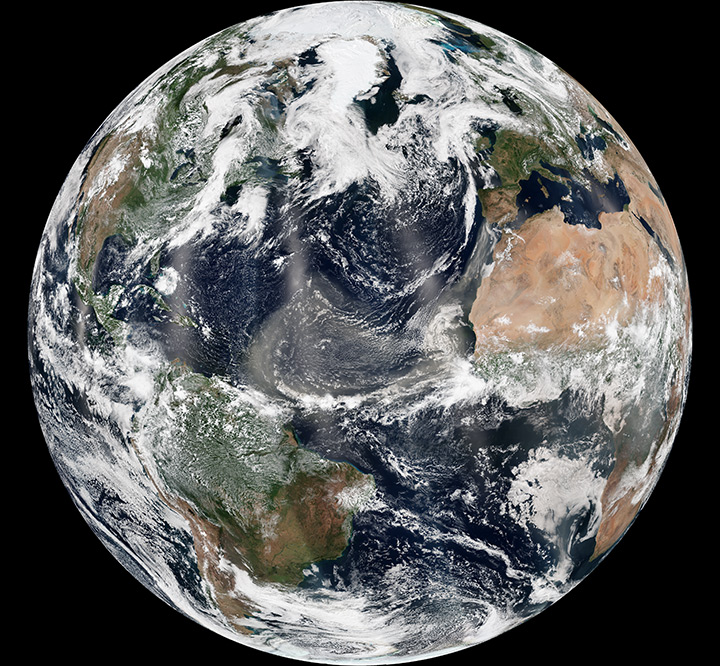
The North Atlantic can be treacherous. Image credit: NASA Earth Observatory image by Jesse Allen and Robert Simmon, using VIIRS data from the Suomi National Polar-orbiting Partnership.
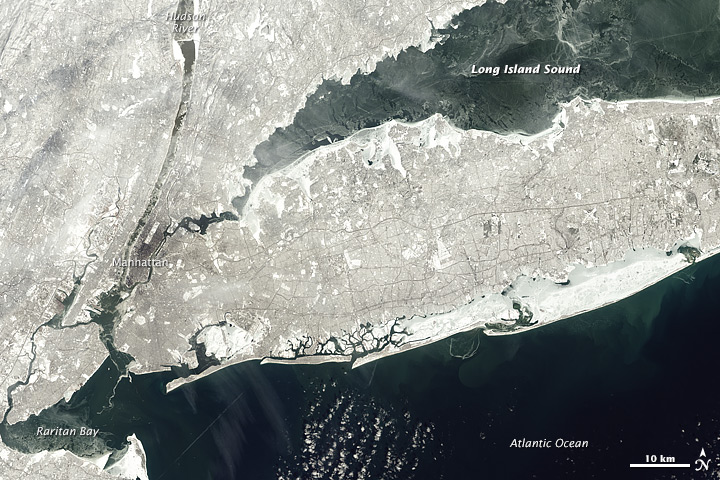
The original destination: the mouth of the Hudson River. NASA Earth Observatory image by Jesse Allen, using Landsat data from the U.S. Geological Survey.
The first half of the two month journey proved to be smooth and uneventful. But in October, they encountered a series of storms that turned the sea into a writhing cauldron. During one particularly bad storm, the ship nearly capsized.
Their intended destination was the northern edge of Virginia Colony, which at the time stretched from to the mouth of the Hudson River. However, the storms blew the Pilgrims off course toward Cape Cod in Massachusetts.
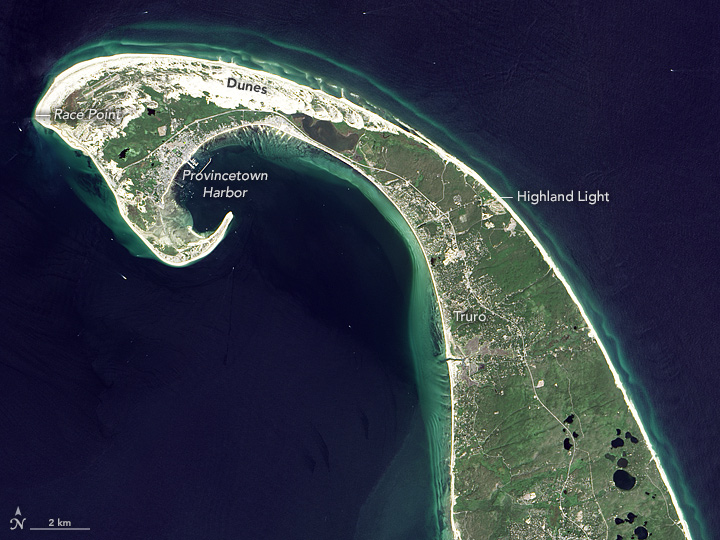
Provincetown, Massachusetts. NASA Earth Observatory image by Jesse Allen, using Landsat data from the U.S. Geological Survey.
When they realized this, they contemplated heading south. However, they were wary of the shallow waters and shoals east and south of Cape Cod and Nantucket—waters full of the sandy, rocky outwash from ancient glaciers. They sailed instead around the northeastern tip of the Cape and on November 21, 1620, dropped anchor just off the shores of modern-day Provincetown. While resting in that harbor, they composed and signed the first self-governing document in American history, the Mayflower Compact.
Over the coming weeks, they made first contact with Native American people, likely the Nauset tribe. First Encounter Beach in Eastham marks the reported location of a skirmish between the colonists and the tribe. The Pilgrims eventually sailed across Cape Cod Bay and settled in Plymouth.
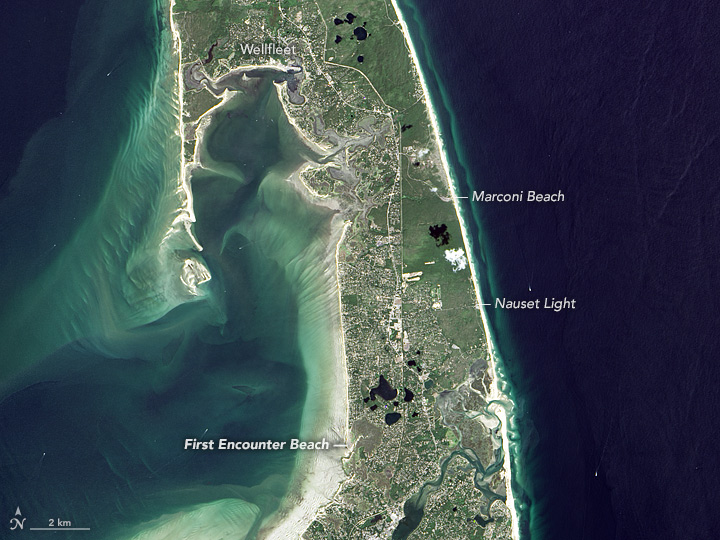
First Encounter Beach. NASA Earth Observatory image by Jesse Allen, using Landsat data from the U.S. Geological Survey.
It was in Plymouth where the Pilgrims celebrated the first Thanksgiving, a three-day harvest celebration that included feasting, games, and military exercises.
While there continues to be debate among historians about the circumstances and influences that led to the first Thanksgiving, there is evidence that the roots of the tradition might be traced back to Leiden. During their time in the city, the Pilgrims would have experienced a celebratory thanksgiving service and festival that was held each year on October 3 to mark the 1574 end of the Spanish siege of the city.
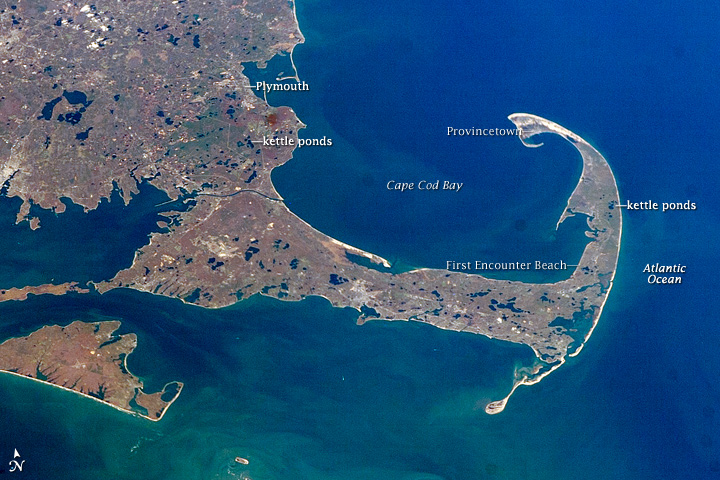
Crossing Cape Cod Bay brought the Pilgrims to Plymouth. This astronaut photograph was acquired on November 7, 2007.





Thank you for this! Love seeing maps along with the detailed history.